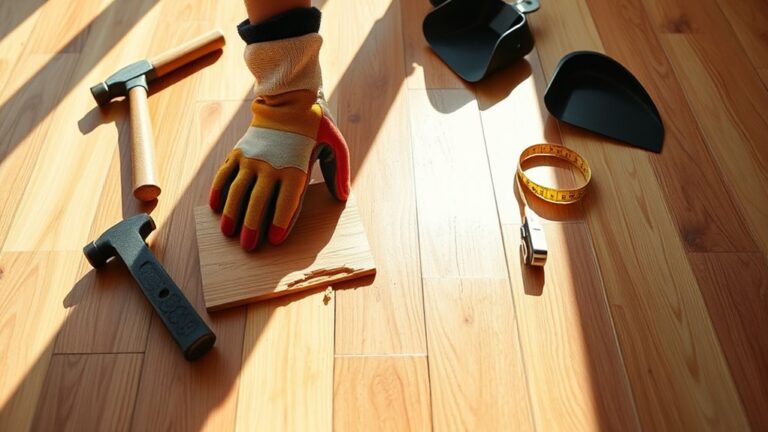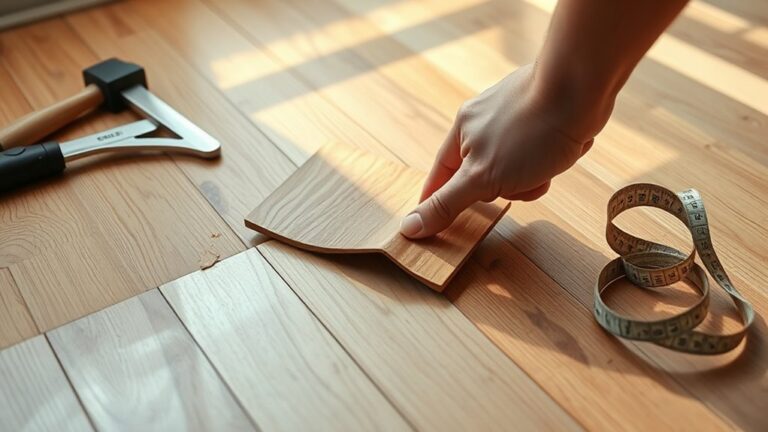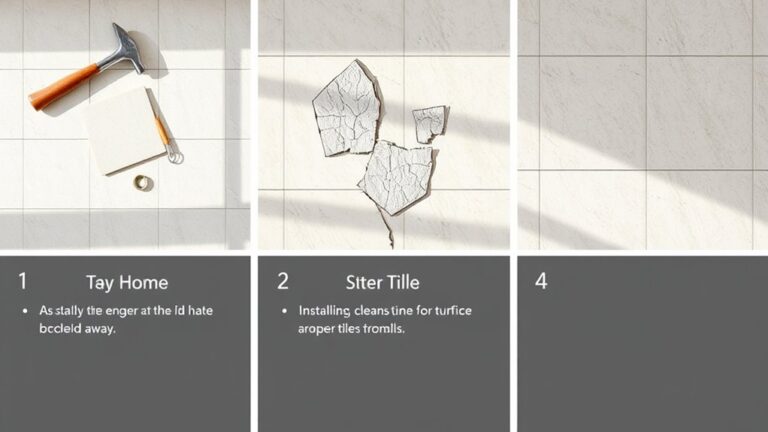To fix scratches on your floors, start by evaluating the damage. Identify if the scratches are superficial, minor, or deep. For minor scratches, clean the area, smooth the surface with fine-grade steel wool, and apply a matching wood wax before buffing it. For deeper scratches, clean, sand following the wood grain, fill with matching wood putty, let it dry, and stain for a seamless look. Always consider the type of wood finish, and take preventive measures, like using rugs and felt pads. If damage is severe, professional help might be necessary, uncovering important insights for your flooring needs.
Assessing Scratch Damage
When evaluating scratch damage on your hardwood floors, start by identifying the types of scratches present. Scratches on wood floors can be categorized as superficial, minor, or deep. Understanding these distinctions is essential since they directly influence the repair methods you might need. Superficial scratches typically only affect the wood finish, while deep scratches penetrate the wood, requiring more extensive intervention.
Next, assess scratch damage by evaluating the severity of each scratch. Take note if the scratches affect only the finish or if they explore deeper into the wood. This assessment will guide you in determining whether simple touch-ups suffice or if you'll need to reflect on sanding and refinishing the affected areas.
Additionally, contemplate the type of wood finish on your floors. Different finishes, such as water-based, oil-based, or varnished, can impact how you approach repairs. For example, oil-based finishes may require different products compared to water-based finishes.
It's also a good practice to document the condition of your floor. Record the location and extent of scratches to create a reference point for future repairs and ongoing maintenance. This documentation will help you track changes over time and decide when professional help might be necessary. If you find widespread or severe damage, don't hesitate to consult a professional. They can accurately assess the situation and recommend the best course of action tailored to your specific needs.
Techniques for Minor Scratches
Although minor scratches on hardwood floors may seem like a small issue, addressing them promptly can prevent further damage and maintain your floor's aesthetic. Here are some effective techniques you can use to fix scratches with minimal effort.
- Clean the Area: Start by wiping the scratch with a soft cloth and a hardwood cleaner to remove dirt and debris.
- Smooth the Surface: Gently rub the scratch with fine-grade steel wool to even out the surface, being careful not to damage the surrounding finish.
- Apply Wood Wax: Use a wood wax repair stick that matches your floor color. Apply it directly into the scratch and let it sit for about ten minutes.
- Buff the Repair: After the wax has set, buff the area with a clean cloth for a polished finish that blends with the existing floor.
- Seal the Repair: For best results, consider applying a clear water-based polyurethane over the repaired area. This will create a protective layer and guarantee a seamless appearance.
Regular maintenance, including quick attention to scratches, is essential. By incorporating these techniques, you not only fix scratches but also enhance the longevity of your hardwood floors. Remember, the sooner you address these minor imperfections, the less likely they are to develop into deeper damage that could require extensive repairs.
Repairing Deep Scratches
Deep scratches on hardwood floors can be particularly troubling, as they not only mar the beauty of your space but can also compromise the wood's integrity. If you're ready to tackle this repair, follow these steps to restore your floor.
| Step | Action | Tool Needed |
|---|---|---|
| 1. Clean the Area | Remove any loose debris from the scratched area. | Cloth |
| 2. Sand the Scratch | Gently sand the scratched portion with fine-grit sandpaper, following the wood grain. | Fine-grit sandpaper |
| 3. Fill the Scratch | Apply wood putty that matches your floor color, packing it tightly and slightly above the surface. | Wood putty |
| 4. Allow to Dry | Let the filler dry completely per the manufacturer's instructions. | N/A |
| 5. Sand Again | Sand the area until it's level with the surrounding floor. | Fine-grit sandpaper |
| 6. Stain or Finish | Apply a matching stain or finish to blend the repair seamlessly. | Stain/Finish |
After cleaning, start by sanding the scratched area gently. This prepares it for the wood putty, which should be applied generously to guarantee a tight fit. Once the filler has dried, sand it down until it's flush with the rest of the floor. Finally, applying a matching stain is essential to achieving a uniform appearance. By following these detailed steps, you can confidently repair deep scratches, restoring your hardwood floor's beauty and integrity.
Preventive Measures for Floors
Protecting your hardwood floors from scratches requires proactive measures that maintain their beauty and longevity. By implementing a few simple strategies, you can greatly reduce the risk of scratches and keep your floors looking pristine. Here are some effective preventive measures to think about:
- Place protective rugs or mats in high-traffic areas to absorb impact and shield against scratches from shoes and furniture movement.
- Attach felt pads to the legs of furniture to minimize the risk of scratches when items are moved or shifted across the floor.
- Regularly sweep and vacuum your hardwood floors to eliminate dirt and debris that can cause abrasion and wear over time, ensuring a smoother surface.
- Implement a no-shoes policy in your home or provide shoe covers for guests to reduce the amount of dirt and potential scratches on the floor.
- Maintain proper humidity levels in your home (between 30-50%) to prevent wood shrinkage and expansion, which can lead to cracks and scratches over time.
When to Seek Professional Help
When it comes to maintaining your hardwood floors, knowing when to seek professional help can save you time, money, and further damage. If you've noticed exposed wood due to finish removal or significant scratches, it's wise to consult professional repair services. These experts can guarantee the restoration is done correctly, preserving the aesthetic and structural integrity of your flooring.
Widespread damage across multiple areas signifies that your floor requires an expert's assessment. DIY methods often fall short when tackling extensive gouges or deep scratches. Professionals come equipped with specialized tools and knowledge that allow them to perform effective floor repair that goes beyond basic patching.
Moreover, if the damage is extensive and the cost of repairs approaches or exceeds the value of the flooring, consulting a professional can help clarify if replacement is a more viable option. This is particularly vital for engineered wood flooring, which typically can only be sanded once. A professional can execute repairs without compromising the floor's integrity, guaranteeing you get the most out of your investment.
Ultimately, if you're facing challenging repairs or have doubts about the extent of the damage, don't hesitate to reach out to a professional. They can provide the necessary expertise to restore your floors, giving you peace of mind and the freedom to enjoy your space without the worry of further deterioration.
Frequently Asked Questions
How Do You Repair Scratches on Floors?
When it comes to your floors, think of scratches as unwelcome guests that disrupt your home's harmony. You can employ scratch prevention tips like using rugs and felt pads under furniture. For floor maintenance strategies, regularly clean and polish your floors. If scratches do appear, DIY repair techniques include using wood wax or a matching repair stick. Always remember to test any product on a small area first to guarantee it's compatible.
How Do You Get Scratches Out of Hardwood Floors Without Sanding?
To get scratches out of hardwood floors without sanding, you can use various scratch repair techniques. Start with DIY scratch remedies like a mix of equal parts apple cider vinegar and olive oil, letting it sit for 24 hours. For deeper scratches, apply a matching wood putty, allowing it to dry before buffing. Regular hardwood floor maintenance, including cleaning and protective coatings, will help minimize future damage and keep your floors looking great.
Will Buffing a Floor Remove Scratches?
You might be surprised, but buffing your floor can actually reduce the appearance of light scratches. By employing effective buffing techniques, you can enhance your floor maintenance routine and promote scratch prevention. Using a soft cloth or fine-grade steel wool while applying a hardwood floor cleaner can blend those scratches with the surface. Keep in mind, though, that buffing won't tackle deep scratches, which require a more intensive repair approach.
How to Fix Scratches on Wood?
To tackle scratches on wood, you'll need some essential repair tools. Start by cleaning the area and evaluating the damage. For minor scratches, a wood wax can fill them effectively. Remember, prevention is key—use scratch prevention tips like area rugs and furniture pads to protect your floors. Regular wood floor maintenance, including cleaning and polishing, will keep your surfaces looking great and minimize future scratches, ensuring your wood floors maintain their beauty.




